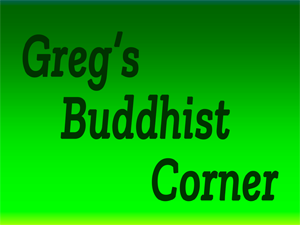Celebrating 40 Years of Tibetan Buddhism in Holland
By Greg Suffanti
QFWF September 2019
This year Maitreya Instituut will celebrate her 40th anniversary, making her one of the oldest Buddhist organizations in the Netherlands. But what is a Dharma center anyway? And how can Tibetan Buddhism help people in the West, who are neither Tibetan, nor Buddhist?
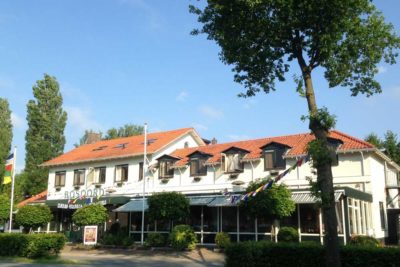
Everyone is always welcome, you don’t have to make an appointment, and Maitreya Instituut is not some kind of club or sect, or even some kind of heavy-duty ‘institute’ filled with unhappy faces: in fact, it’s a place where you’ll learn how your mind works and how you can help yourself to be happier. That’s all! That is the purpose of a Dharma center. The teachings of the Buddha are collectively called the Dharma. It is said in Buddhism that there are 84,000 types of mind, and thus the Buddha gave 84,000 teachings. Maitreya Institute offers all levels of courses covering the entire Tibetan Buddhist path, plus meditations, thangka painting lessons and much more.
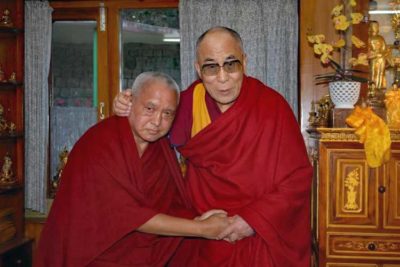
For a calendar of events please go to: www.maitreya.nl
There are a lot of misconceptions about Tibetan Buddhism and there are a lot of scandals these days in the era of #MeToo. Tibetan Buddhism’s reputation has been recently damaged by a number of high-profile cases involving criminal behavior by senior members of the community.
I wrote about some of these problems last year for this website. One of the subjects of my article, Sogyal Rinpoche, died in August of this year in Thailand from cancer at age 72.
“In 40 years of existence, there has never been a scandal, an accusation of impropriety, or any other such problem at Maitreya Instituut, and that is the truth. It has been the great honor of my life to be a volunteer these last nineteen years at Maitreya Instituut and to be able to contribute in some small way to the continuing success of a place I call ‘home’.”
This article is a small glimpse of Maitreya Instituut’s history, with some personal reflections as well, from some of the people who help keep the doors open for anyone wishing to enter. Welcome.
“It all began with Lama Yeshe …” Paula de Wys
Sometimes, one encounter can change the course of your entire life
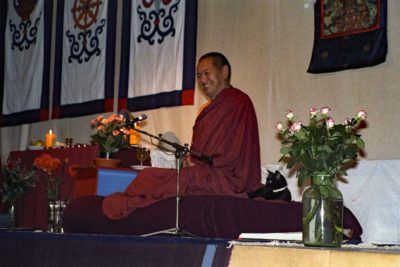
In the early 1970’s, a young American from New York City named Paula Koolkin was traveling with her Dutch boyfriend, Matti de Wys, and they were doing the “hippie thing”, visiting India, Afghanistan and Nepal, when she met two Tibetan Lamas; Lama Yeshe and his pupil Lama Zopa, at their recently started Kopan Monastery, on the outskirts of Kathmandu, Nepal.
Little could she imagine then, now in her seventies, that her entire life was about to change, forever. The Tibetan Lamas were just starting to give Dharma lessons to Westerners in English at their Kopan Monastery and Paula just so happened to be there for their third Dharma course, given in 1972. Paula says, “as if it was planned, I sat between the only two Dutch people in attendance, and so that is how I met Marcel Bertels,” who would soon become a monk and eventually play a pivotal role in being among the earliest in bringing organized Tibetan Buddhist teachings to the Netherlands. Paula, who married Matti de Wys and settled permanently in the Netherlands, would also come to play a pivotal role.
Fast-forward two years.
“Everything about Maitreya Institute in the early years was due to Lama Yeshe” Paula de Wys
One day in 1974, Paula de Wys received a letter from Lama Yeshe in Kopan, asking her to organize a Lam Rim course for the now ordained Marcel Bertels, somewhere in Holland. The Lam Rim is an overview of the stages of the entire Buddhist path, and Paula says the first course was a big success with about 15 people in attendance. In the second year, Jan Paul Kool attended, and was so impressed with Marcel Bertels, and with hearing the Dharma in his native Dutch, that he thought, “I’ve come home. This is something everyone should hear!” Jan Paul even traveled to Manjushri Institute in England with his then girlfriend Margot, just to hear more about Buddhism. He too, would come to play a pivotal role in creating what is now Maitreya Instituut. Margot too.
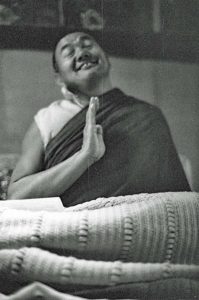
Paula de Wys, who still sits on the board of Maitreya Instituut, and is director of the Amsterdam center, says, “everything that could be said about Maitreya Instituut in the early years began with Lama Yeshe.”
“Lama Yeshe sent Marcel, gave the name, and Lama Yeshe married Jan Paul and Margot. Lama Yeshe inspired us. He had a simple hippy-English that touched your heart, and he could explain the most complex ideas in an easy to understand manner. Lama Yeshe was the inspiration for everything, we just did the work.”
Lama Yeshe suggested a magazine in Dutch because there was so much garbage about Buddhism
1979 was the year that Maitreya Instituut formally began. Jan Paul Kool recalls that;
“Lama Yeshe’s visit in 1979 formed the beginning of the institute. We (Truus Philipson, Margot, Paula and myself) asked Lama Yeshe what we could do to go forward. He advised us to organize a Dharma lesson one time per month, and to produce a Dutch language magazine so that people could read about the Dharma in their own language, because there is so much garbage written about Tibetan Buddhism.”
‘Maitreya Magazine’ was the result, and the publication ran regularly until the last issue was published in 2006. Today, ‘Maitreya Newsletter’, a digital newsletter, brings information quarterly to the nearly 600 subscribers.
“Just before Christmas 1979, we sat with a notary to register Maitreya Instituut. The institute was called ‘Stichting Maitreya Instituut for Wisdom-Culture’,” recalls Jan Paul. “Lama Yeshe said, ‘it’s not about an eastern culture or a western culture, but a wisdom culture.’”
Maitreya Instituut had officially begun, with Paula de Wys as the chairperson, Jan Paul Kool as the treasurer, and Margot Kool as the secretary. There were increasingly more people attending the weekend courses, and by 1981, a large country house in Bruchem was found to accommodate the ever-expanding group. There was an effort made to invite teachers from all traditions, like Namkhai Norbu Rinpoche, Sogyal Rinpoche and Gelek Rinpoche.
With a move to Maasbommel in 1984, Dagpo Rinpoche visited and in Emst we had Geshe Ngawang Zopa. It is interesting to note, that the five lamas mentioned above all went on to develop centers of their own in the Netherlands. Thus, Maitreya Instituut helped spread Buddhism in the Netherlands by bringing qualified teachers to an expanding audience, helping the entire Buddhist community to grow and to thrive.
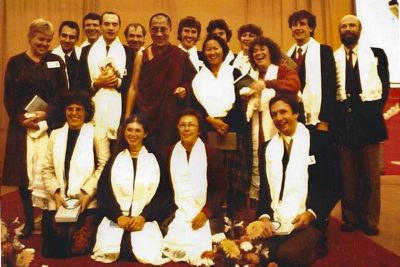
In 1986, Lama Zopa said, “it’s time to start to look for a place to buy instead of renting, because renting is like throwing money away.”
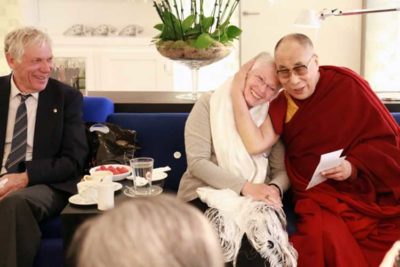
In 1987, the center bought an old youth hostel in Emst. Jan Paul started Maitreya Uitgeverij, a publishing concern, that would go on to publish many titles, including some from the institute’s own teachers. From 1987 until his retirement in 1991, Geshe Konchog Lhundrup was the center’s resident teacher. Geshe Sonam Gyaltsen arrived in 1992 as the resident teacher in Emst, and the center relocated in 2012 to a former conference center and hotel in Loenen, in the Veluwe forest, not far from the old center in Emst.
In 1998, the Amsterdam center was begun after a large building was donated by one of Lama Zopa Rinpoche’s students. The center, then located in the Jordaan neighborhood on the picturesque Brouwersgracht, welcomed Australian Buddhist nun, Ven. Kaye Miner, in 1999 as its resident teacher. Ven. Kaye’s deeply detailed knowledge of the Dharma and humorous anecdotes, often relating her own experiences from working as a manager in the business world, meant that the center grew and thrived for many years until illness forced her into retirement in 2017. Her skills as a manager were useful as well, as she was the director of the Emst center for a number of years, while still retaining her teaching duties. Her successor, Ven. Losang Gendun, is profiled later in this article. In 2012, the Amsterdam center relocated to the Tilanusstraat, next to the Hogeschool of Amsterdam.

Jan Paul Kool retired in 2011, and sadly, his wife Margot died unexpectedly in 2012.
Geshe Sonam Gyaltsen: Patriarch, Author & Buddhist Master
The Heart of a Buddhist Center is the Teacher; the Students, its Lifeblood
He’s never been jealous even once in his life
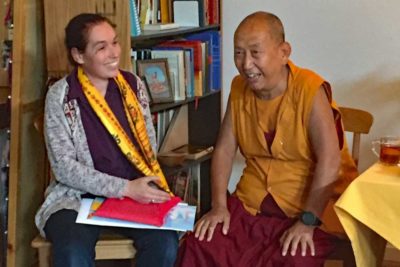
Since 1992, Geshe Sonam Gyaltsen has been Maitreya Instituut’s resident teacher. Geshe Gyaltsen was born in 1941 into what his grandmother called a “lama lineage family” in Lhasa, Tibet. In fact, Geshe la’s father was a Geshe before marrying. In 1959 he escaped the Chinese invasion of Tibet on foot with seven friends, sleeping in the snow, without blankets, on a one-month trek through the Himalayas to India.
In addition to escaping from Chinese soldiers in Tibet, he spent three years in India working the fields to help rebuild his monastery, Gaden Jangtse, in Mundgod. In 1979, he graduated from Sera Je Monastery in S. India as a Lharampa Geshe, the highest possible ranking. Geshe Sonam Gyaltsen additionally has a Ngagrampa degree and an Acharya degree.
He has given hundreds of courses ranging from the Lam Rim to various Highest Yoga Tantra initiations, explained countless rituals and mudras and written numerous books. Although he’s been officially offered the title of “Lama”, he’s refused it, preferring the simpler title of Geshe. He is considered traditional in his approach, and recommends 5 years of study with one teacher before teacher and student even consider making more formal commitments to each other in the form of a refuge ceremony. Some Lamas will give tantric initiations to complete strangers; Geshe Sonam Gyaltsen prefers the old-fashioned way, with teacher and student actually knowing each other. ‘Caveat emptor’, let the buyer beware. Geshe Sonam Gyaltsen is greatly respected by his peers; his academic record is truly impressive, and his ethics and morality unassailable. Most importantly, he has earned the love and respect and devotion of his many students.
He has publicly stated that he’s never been jealous even one time in his life.
I have had numerous teachings through the years from Geshe Gyaltsen, especially during his years of traveling to Amsterdam once a month to give an afternoon Dharma lesson. I have always been impressed at his extreme clarity and deep understanding of every topic he teaches on, and always without even looking at a text. I’ve seen him making offerings wearing a mask over his mouth to keep the offerings as pure as possible. This great care and respect seem to emanate from his being all the time. He has a peaceful luminosity, a quiet presence, and a hearty laugh; just like you would hope to find in a Tibetan Lama. There is no question that it is Geshe Gyaltsen’s living example of what it means to traverse the Buddhist path that inspires his many students to devote their lives to helping their center and their teacher thrive in the Netherlands. For more than 24 years, Hans van den Bogaert translated Geshe Gyaltsen’s teachings from Tibetan into English until his retirement in 2016. His current translator is Dutch born Ven. Tenzin Pellha.
He appeared, as if magically, whenever there was a real problem
I’ve heard many stories through the years of Geshe Gyaltsen being clairvoyant, and my friend Thirza Dodd swears that when she was living at the center, he’d “appear as if magically, whenever there was a real problem.”
His latest book, “A Life Story”, is 695 pages and chronicles his early life in Lhasa, coming from a prominent family in Tibet, to his years in a former prison camp in Buxaduar, in India, through to his many experiences and impressions of the West in general, and Holland specifically. Geshe Sonam Gyaltsen paints a vivid picture all along the way in this adventure-filled story, full of fascinating cultural anecdotes and personal stories. He is highly regarded in the Tibetan Buddhist community as an accomplished academic, and he is widely respected by his students as a humble and learned traditional Buddhist master. Geshe Gyaltsen has lived modestly as a monk, on premises at the center in both Emst and Loenen since arriving the Netherlands.
Prior to working in the Netherlands, Geshe Sonam Gyaltsen served as the head of Gaden Jangtse school for five years as well as its Chanting Master for five years.
Geshe Sonam Gyaltsen is also founder of the Dhonden Foundation, which helps to support the Gaden Jangtse Monastery, the first monastery of the Gelugpa school of Tibetan Buddhism, which was founded in 1409 by Lama Tsong Khapa, and re-established in S. India after the Chinese invasion of Tibet.
When I asked friend, student, and former co-director of Emst, Thirza Dodd, to comment on her years as Geshe la’s student and assistant, she responded:
“Having heard 6 of Geshe la’s weekend courses on the Lam Rim, it was his wisdom, deep compassion and total integrity that broke through my long held skepticism about spiritual communities and spiritual teachers. I felt suddenly compelled to ask him to be my ‘Teacher’, and as he replied to me, I watched him become very small, his humility was overwhelming.”
“Some 10 years later, after receiving the Guhyasamaja initiation from Geshe la, he came over to shake my hand and he seemed to be of very large stature. In the intervening years my devotion to him has grown as I’ve experienced the enormous joy that he exudes. Not only due to his wonderful sense of humor, which came through even in the midst of the most serious Buddhist teachings, but also every time I would go to large gatherings where Geshe la would meet up with fellow Tibetan Lamas. He would approach a group of monks in deep, serious-looking discussion and within minutes would have them all laughing.”
The Importance of the Teacher, or Guru, on the Buddhist Path
Guru devotion in an unavoidable topic in Tibetan Buddhism
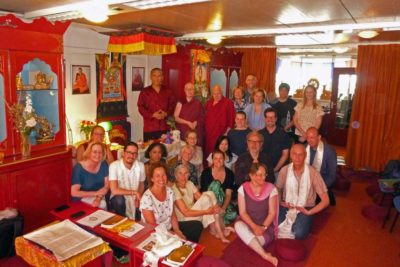
For Tibetan Buddhists, the teacher is the heart of the center, and the students its lifeblood. You can tell by the atmosphere of the center, the quality of its teachers. Since retiring from teaching, Ven. Kaye Miner now also lives at the center in Loenen, and although not teaching, she’s always lending her ear, her humor and her goodwill to benefit the center each and every day. For someone like me, who regards Ven. Kaye and Geshe Gyaltsen as their teachers, the relationship goes beyond the mere sphere of teacher and student, to one of refuge in the heart, and that transcends profession and place and even life itself.
To the average Western outsider, words like refuge, guru and devotion are loaded with negative connotations. This is understandable, given the seemingly endless ethical problems, moral failings and criminal cover-ups that have plagued vast sections of organized religion for decades. It might be interesting to note that in Tibet there is no label of ‘Buddhist’, rather, a person is considered an ‘insider’, or someone who looks inward to solve their problems. This more accurate way of looking at Buddhism, as an ‘insider’, might be helpful when considering what Buddhism actually is, rather than being distracted by all the ceremonies, exotic visuals, words like guru, devotion and lama and myths and misconceptions about Tantra?
I’ve learned to trust myself and my instincts
There’s always talk of ‘guru devotion’ in Tibetan Buddhism, but actual guru devotion is something that needs to happen over time, naturally and organically in my opinion. It is an affair of the heart and mind, and may be the most important decision you’ll ever make in your spiritual life, so there should never be a rush to consider your teacher “Your Guru.”
Historically, a topic like guru devotion came at the beginning of the Buddhist path, because the teachings were being given to monks, who already understood the importance of the teacher and one’s relation to him/her. However, a topic like guru devotion can be difficult, especially for Westerners, and many Western Buddhist teachers have started to teach on other topics first, before coming back to guru devotion later in their programs. However, guru devotion is an unavoidable topic within Tibetan Buddhism, because it is an oral tradition, and the teacher/student relationship is said to be the most important factor in being able to successfully traverse the Buddhist path. Lama Zopa Rinpoche calls guru devotion the “Heart of the Path.”
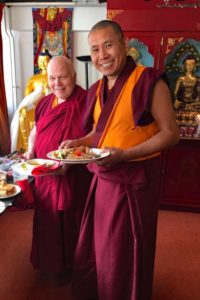
My own experience has been that the more time I spent around my teachers, the more I respected them, and began to appreciate some of their extraordinary qualities. I’ve never forced myself in any way with Buddhism; and certainly, regarding making commitments, well, it came naturally … it was something I wanted to do. I’ve learned to trust myself and my instincts over the years. Geshe Ngodrup has said:
“First you have your refuge in your teachers,
In the middle you have refuge in the teachings themselves, in Dharma,
Finally, at the end, you have refuge in yourself.”
I found the idea of prostrating to someone way too extreme in my early years. It took me a number of years of really looking, watching, and examining my teachers, like I would if I were buying gold, before accepting not only their tremendous good qualities and vast knowledge in my mind, but most importantly, accepting them fully in my heart. There’s a big difference when someone really touches your heart; another, more secret, protective and hurt part of the self opens, and there is a chance to heal and profoundly change. I guess you could call this the blessings of the teacher. Anyway, this has been my experience.
Slowly, slowly, the teacher helps you to grow
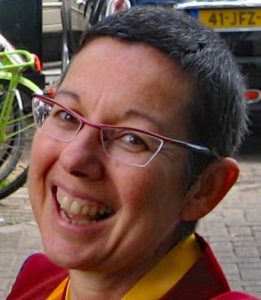
After a few years I managed to reduce my ego a bit, thanks mostly to Ven. Kaye Miner and her good-natured prodding, and this also helped me to realize how much I’d grown to love and respect my teachers and would happily prostrate to them because of this simple fact; whereas a few years earlier I would have found the idea obsequious or at least unappealingly cultish. In my case, by the time I started prostrating to my teachers, I’d figured out that they were only trying to help me, and I wanted to show my respect and love. You show your love and respect for the Dharma itself by prostrating to the one giving you the Dharma lesson … only if you feel inclined to do so. For example, if I attend Buddhist teachings and I don’t know the Lama, I don’t prostrate. It’s a personal choice, always.
Slowly, slowly, the teacher helps the student to grow. If you are looking for a quick fix, chances are the fix will be temporary as well. Tibetan Buddhism is always looking at how best to cultivate lasting, stable happiness. From the Buddhist perspective, the best way to begin this process of transformation is to find a qualified teacher and then begin to devote yourself to this person, following their advice. You must have great care in selecting a teacher, as this relationship is the basis for further growth. Trust and respect should be reciprocal. No person should ever pressure you, and anything you decide should always be respected.
Something like refuge links you to the teacher forever, beyond this life
You never have to consider a teacher a guru if you don’t want to, and something as personal as taking refuge should only be done out of a great personal desire to do so. From the Buddhist perspective, taking refuge with a teacher links you for not only this life, but many lives to come. These things should never be done lightly.
In fact, you should never feel rushed or pressured. If you feel this, you should be discerning in determining what is actually going on. There never needs to be a rush to make formal commitments. Why would there be? Geshe Rinchen has told me that in the East, unscrupulous lamas are quite common, whereas in the West they are less prevalent. The best rule of thumb is to always be careful when looking for a teacher, and then to follow your instincts and your heart, and ultimately your own wisdom… preferably in that order.
From the Tibetan Buddhist perspective, devoting yourself to your guru/teacher is of paramount importance. Lamas know that we Westerners have a bit of difficulty with authority figures, reasoning that these lamas are just like us. We are skeptical in the West and most lamas think this is very good. To a point. In his book, “The Heart of the Path”, Lama Zopa lays out in great detail why the ‘guru’ is so important, and how we can work with our own doubts and superstitious thinking to overcome this problem of seeing the teacher as a Buddha, so that we “can get the biggest profit” from our relationship with our teacher. Lama Zopa explains:
“Guru Devotion is the Root of the Path” Lama Zopa Rinpoche
“Guru devotion, seeing the guru as Buddha, is called ‘the root of the path’ because just as the trunk, branches, leaves and fruit grow from the stable root of a tree, all realizations of the graduated path to enlightenment grow from stable devotion to the guru. If there is no root, nothing can grow. Just as a tree depends on its root, all the realizations from perfect human rebirth up to enlightenment depend on guru devotion. If we have the stable root of guru devotion, all realizations come quickly.” (p. 167, “Heart of the Path”)




